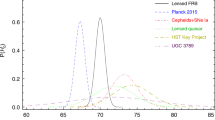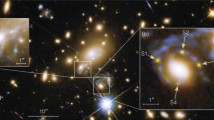Abstract
Fast Radio Bursts (FRBs) are new transient radio sources discovered recently. Because of the angular resolution restriction in radio surveys, no optical counter part has been identified yet so it is hard to determine the progenitor of FRBs. In this paper we propose to use radio lensing survey to constrain FRB progenitors. We show that, different types of progenitors lead to different probabilities for a FRB to be gravitationally lensed by dark matter halos in foreground galaxies, since different type progenitors result in different redshift distributions of FRBs. For example, the redshift distribution of FRBs arising from double stars shifts toward lower redshift than of the FRBs arising from single stars, because double stars and single stars have different evolution timescales. With detailed calculations, we predict that the FRB sample size for producing one lensing event varies significantly for different FRB progenitor models. We argue that this fact can be used to distinguish different FRB models and also discuss the practical possibility of using lensing observation in radio surveys to constrain FRB progenitors.
Similar content being viewed by others
References
Thornton D, Stappers B, Bailes M, et al. A population of fast radio bursts at cosmological distances. Science, 2013, 341, 53–56
Navarro J F, Frenk C S, White S D M. A universal density profile from hierarchical clustering. Astrophys J, 1997, 490: 493–508
Li L X, Ostriker J P. Semianalytical models for lensing by dark halos. I. Splitting angles. Astrophys J, 2002, 566: 652–666
Li L X, Ostriker J P. Gravitational lensing by a compound population of halos: Standard models. Astrophys J, 2003, 595: 603–613
Press W H, Schechter P. Formation of galaxies and clusters of galaxies by self-similar gravitational condensation. Astrophys J, 1974, 187: 425–438
Eisenstein D J, Hu W. Power spectra for cold dark matter and its variants. Astrophys J, 1999, 511: 5–15
Hinshaw G, Larson D, Komatsu E, et al. Nine-year Wilkinson Microwave Anisotropy Probe (WMAP) observations: Cosmological parameter results. Astrophys J Suppl Ser, 2013, 208: 19
Schneider P, Ehlers J, Falco E E. Gravitational Lenses. Berlin: Springer-Verlag, 1992
Falcke H, Rezzolla L. Fast radio bursts: The last sign of supramassive neutron stars. Astron Astrophys, 2014, 562: A137
Popov S B, Postnov K. Hyperflares of SGRs as an engine for millisecond extragalactic radio bursts. arXiv:0710.2006
Popov S B, Postnov K. Millisecond extragalactic radio bursts as magnetar flares. arXiv:1307.4924
Totani T. Cosmological fast radio bursts from binary neutron star mergers. Pub Astron Soc Jpn, 2013, 65: L12
Kashiyama K, Ioka K, Mészáros P. Cosmological fast radio bursts from binary white dwarf mergers. Astrophys J, 2013, 776: L39
Loeb A, Shvartzvald Y, Maoz D. Fast radio bursts may originate from nearby flaring stars. Mon Not R Astron Soc, 2014, 439: L16–L50
Zhang B. A possible connection between fast radio bursts and Gamma-ray bursts. Astrophys J, 2014, 780: L21
Deng W, Zhang B. Cosmological implications of fast radio burst/Gamma-ray burst associations. Astrophys J, 2014, 783: L35
Virgili F, Zhang B, O’Brien P, et al. Are all short-hard Gamma-ray bursts produced from mergers of compact stellar objects? Astrophys J, 2011, 727: 109
Cole S, Norberg P, Baugh C M, et al. The 2dF galaxy redshift survey: Near-infrared galaxy luminosity functions. Mon Not R Astron Soc, 2001, 326: 255–273
Li L X. Star formation history up to z=7.4: Implications for gamma-ray bursts and cosmic metallicity evolution. Mon Not R Astron Soc, 2008, 388: 1487–1500
Tan W W, Cao X F, Yu Y W. Determining the luminosity function of swift long Gamma-ray bursts with pseudo-redshifts. Astrophys J, 2013, 772: L8
Guseinov O H, Yazgan E, Tagieva S O, et al. The pulsar luminosity function. Astron Astrophys, 2003, 39: 267–274
Turner E L, Ostriker J P, Gott J R. The statistics of gravitational lenses—The distributions of image angular separations and lens redshifts. Astrophys J, 1984, 284: 1–22
Author information
Authors and Affiliations
Corresponding author
Additional information
Contributed by LI LiXin (Associate Editor)
Rights and permissions
About this article
Cite this article
Li, C., Li, L. Constraining fast radio burst progenitors with gravitational lensing. Sci. China Phys. Mech. Astron. 57, 1390–1394 (2014). https://doi.org/10.1007/s11433-014-5465-6
Received:
Accepted:
Published:
Issue Date:
DOI: https://doi.org/10.1007/s11433-014-5465-6




